Menus
- Welcome to excess Harley-Davidson
- V2, 1923 cm3, 105 hp at 5450 rpm, 166 Nm at 3500 rpm, 385 kilos dry, from € 41,290
- Discovery
- In the saddle
- Engine and transmission
- In the city
- On highways and main roads
- On departmental
- Part-cycle
- Brakes
- Comfort and duo
- Consumption & autonomy
- Conclusion
Welcome to excess Harley-Davidson
V2, 1923 cm3, 105 hp at 5450 rpm, 166 Nm at 3500 rpm, 385 kilos dry, from € 41,290
From when, too much is enough? What we mean by that is that a big Harley-Davidson has long been a 1340. then a 1450. Then a 1584 (96 cubic inches). Then a 1690 (103 cubic inches). Then the generation of Milwaukee Eight engines gave the 107 (1745 cm3) and 114 (1868 cm3) and there it was really starting to fail. But that’s not all: the limited series of the CVO line (for Custom Vehicles Operations) have always been entitled to a small bonus: here comes the 117 engine, which tops the range with its 1923 cm3. It starts to hurt for a twin, no ?
The CVO is top of the range: we not only have the largest engine available, it is also the highest level of equipment and finish. The CVO range this year includes the Ultra, Street Glide and Road Glide. This is the last one we had on trial.
Before going any further, a few figures: 1923 cm3, more than 400 kilos in running order and more than € 41,000! So is it too much? Or is it just too good? To find out, nothing like a test.
Discovery
The formula is not mine, but a colleague journalist (in a small fanzine which organizes demonstrations): according to him, before, a Harley CVO, it was "a motorcycle of circus boss". It must be said that between the abundance of chrome, the plastiwood-style faux wood dashboard veneers®, the deep glittery paints, the machine was not intended for introverted souls.
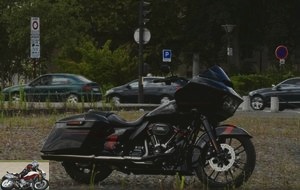
Recently, a change of program: the CVOs give in a form of classy darkness that approaches the "dark custom" spirit so dear to the Milwaukee brand. Suddenly, it almost borders on a certain form of discretion, which involves approaching the bike to see the extent of the difference compared to a standard Road Glide or even Special (one which, like the Road King Special, has a large part of its components, engine, transmission, running gear, covered in black). But, once the nose is on, we discover the depth of the paintings, quite unique in the genre and we must admit that it gives it a sacred allure..

Now is there a big difference to a normal Road Glide or a Road Glide Special? Yes, of course, but you have to have your nose in it to realize the difference in finish, depth of paint and equipment..
On the other hand, there is still a difference: the Road Glide CVO has and this is a first in the Touring Harley range, a 21-inch front wheel..
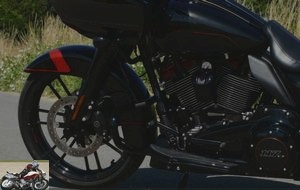
In the saddle
680 mm saddle height: it’s accessible to everyone, that. 385 kilos dry: that can actually put off some. It is true that when maneuvering at a standstill, it is absolutely necessary not to make him take a heel otherwise, the matter can quickly get tough. Once you have grasped this facet of things and acquired the basics of how to ride a big cruiser, you discover a machine that is quite docile, rather agile and well balanced, well served by a flexible engine..
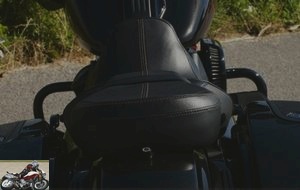
On the other hand and in spite of the 21-inch front wheel, there is no noticeable difference here with a normal Road Glide..
The same applies to the cockpit, with the exception of the trim. We therefore discover a very complete dashboard, just like the Boom Box 6.5 infotainment system, with GPS, Bluetooth function, all easily controlled by two joysticks on the right and left stalk switches, a touchscreen interface and shortcut buttons.

Engine and transmission
There, that changes and it is besides the heart of the understanding of this CVO. Two years ago, in fact, Harley-Davidson launched the Milwaukee-Eight generation of engines, available in 107 ci (1745 cc) and 114 ci (1868 cc), depending on the version. In doing so, the Milwaukee brand took a leap forward in performance and smoothness. Ladlely, the 107 (100 x 111.1 mm) comes out between 86 and 90 hp depending on the machines and the cooling and exhaust systems, as well as 145 to 150 Nm of torque. The 114, on the other hand, is good for a little over 90 horsepower and 155 Nm, with its engine which measures 102 x 114.3 mm. To obtain the 117 (1923 cm3), Harley-Davidson increased the bore of the 114: we are therefore on dimensions of 103 x 114.3 mm.

The Harley-Davidson France site is rather stingy in technical data; fortunately, our Teutonic friends have more rigorous legal provisions (ah, the famous Teutonic rigor!). Suddenly, we learn that the 117 develops 105 horsepower at 5450 rpm and balances 166 Nm of torque, which begins to do for a motorcycle engine, in absolute terms and for a twin cylinder in particular, even if the horses for a custom, that’s really not what we are looking for first. It would even be at odds with the custom spirit.
In fact, this unit is quite quiet at idle as in action. It is extremely supple and velvety at very low revs, accepting to pick up on a trickle of gas, or even a little below 2000 rpm on the last report. The 117 is really consistent in a range 3000/5000 rpm and is even lively at "high" speed. High, in relation to its architecture, that means between 4500 and 5500 rpm.
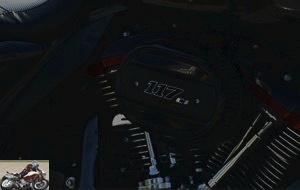
We will have understood: this engine is a treat and yes, it still brings a little more than the 114.
In the city
Once the size and weight are well integrated, we discover a rather well balanced machine that can be handled quite easily between the lines of cars, understood that the gymkhana will never be his thing. Smoothness of the engine and controls, firm gearbox, but precise, everything is fine. As on all big Harleys, summer brings out a small abundance of caloric lifts, even if the Milwaukee Eight generation is in progress compared to the previous ones. Despite its larger displacement, it does not heat up more than the 107 or 114.
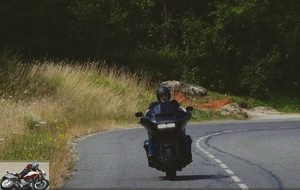
On highways and main roads
Barely more than 2000 rev / min in sixth: the CVO 117 traces its route, imperial. As on all bagger-influenced machines from the brand, we may blame a small lack of protection on the face, which becomes more painful at speeds that American bikers do not generally practice, so everything is explained. . Still, to trace the route for a long time, a deflector on the top of the fairing would not have hurt.
For the rest, it’s happiness: relaxed driving position, cool ergonomics, efficient and charming engine, the kilometers go by in peace..
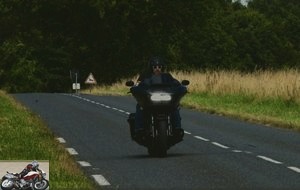
On departmental
It is always astonishing to see how easily such a liner swings from one curve to another, in complete relaxation. Obviously, on bumps, the weight and inertia call to order and the room for maneuver narrows. But on good asphalt and on the condition of not driving like a pig, it takes real pleasure to roll up, without dragging yourself, by drawing pretty well rounded trajectories and by showing other bikers, sometimes amazed, that a good Harley. conducted, it works pretty well. As has been said, this type of motorcycle is obviously better suited to relaxed driving, but during occasional acceleration, the 117 really drops off and the extension it shows is a source of joy, admittedly simple, but no less intense.
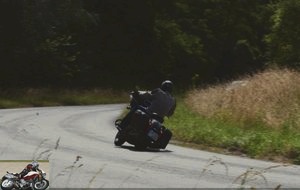
Part-cycle
Apart from the 21-inch front wheel, fitted with a 130 x 60 tire, the Road Glide CVO has a chassis equivalent to that of other Road Glides. It will be recalled that the chassis of the entire Touring range was completely revised two years ago, that all this is based on new rear shock absorbers, adjustable, as well as on a new cartridge fork..
Brakes
Three disc brakes with 4-piston calipers, at the front and at the rear: the device is sufficient given the vocation of the bike, even if there is still weight and that we can, sometimes, arrive a bit quickly. As a bonus, a good dosage and an ABS unit not too dropped. It will be recalled that with these motorcycles, the rear brake plays an essential role.
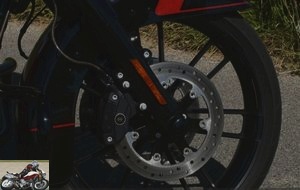
Comfort and duo
For the rider, nothing changes compared to a classic Road Glide: a small deficit of wind protection, but a good saddle, a relaxed position and enough to consider carving the road in peace, despite the shock absorbers a little dry on bumps. For the passenger, on the other hand, the CVO offers better with a flat saddle (they are oddly sloping towards the rear on the other models, which is difficult to understand), with even a small rim on the rear to fit well. stall. Given the potato of the machine, on the other hand, we can consider a small sissy bar in case of frequent duet.
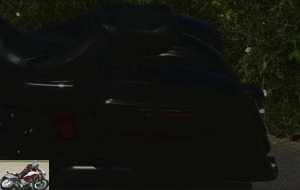
Consumption & autonomy
During this test, we noted a reasonable consumption, of the order of 6 to 6.5 l / 100, which leaves more than 350 kilometers of autonomy. Sufficient for tourist use. We remind you of the presence of a fuel gauge and an autonomy indicator.
Conclusion
Finish, engine: these are the two arguments of this CVO. Compared to a standard Road Glide, in 107, there is obviously a plus. Compared to a Road Glide Special, all dressed in black, the difference in presentation will only jump to the eyes of insiders. But it is obvious that a CVO is for connoisseurs, enthusiasts. Because the price difference is still significant: it is the price of rarity, of course, it is also the price to stand out in a world of fans where every detail counts and, above all, can mark its difference. For those who do not have the sum of a CVO, a standard Road Glide already does a lot of service and is already a pleasure. Certainly, this big engine 117, what happiness !
Nevertheless: more than 41,000 euros, the bill is steep. And in the dairy opposite, we have an Indian Chief in Elite finish, just as neat, at 34,000 euros. But with this type of motorcycle, we are obviously in a world where the element of rationality has somewhat disappeared. Only the passion remains. It’s beautiful, passion.
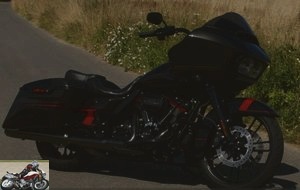
Strong points
- Look
- Finish quality
- Full equipment
- More enjoyable duo than on the non-CVO Road Glide
- Power, torque, flexibility: exceptional engine pleasure
- Driving pleasure
Weak points
- Tariff (downright) in the upper echelons
- A small lack of aero protection
The Harley-Davidson Road Glide CVO technical sheet
Test conditions
- Itinerary: small varied roads + interurban highways with a bit of town
- Motorcycle mileage: 4000 km
Competition: Indian Chieftain Elite
Related articles
-
Harley-Davidson Street Bob 107 test
V2, 1745 cm3, 86 hp at 5020 rpm, 145 Nm at 3000 rpm, 297 kilos, from € 14,860 A change in philosophy from the Dyna family to the Softail family It’s been…
-
Harley-Davidson CVO Street Glide 114 test
V2, 1868 cm3, around 100 hp, 165 Nm, 398 kilos with full fuel, € 39,550 A certain vision of the exception made in Milwaukee and a really punchy 114…
-
Harley-Davidson Freewheeler Test
V2, 1750 cm3, approx. 90 hp, 152 Nm at 3250 rpm, 492 kilos dry, from € 29,850 A stylish and stripped-down three-wheeler to discover the Harley-Davidson…
-
Harley-Davidson Sport Glide 107 Test
Touring and sport at the same time: absolute versatility according to Harley V2, 1745 cm3, 84 hp at 5400 rpm, 145 Nm at 3250 rpm, 304 dry kilos, from €…
-
Harley-Davidson CVO Limited ‘114’ test
New 8-valve Milwaukee-Eight engine for this absolute top of the line from Harley 1870 cm3, approx. 100 horsepower, 166 N.m at 3250 rpm, 414 kilos dry,…
-
Double disc brake and inverted fork: a more dynamic version of the Sportster 1200 4 “Dark Custom” colors, from € 12,590 Globally, Harley-Davison remains…
-
Harley-Davidson Road Glide Ultra test
1700 cm3, 80 hp, 138 Nm of torque, cruise control, GPS, audio, € 27,850 A test over almost 4,000 kilometers from Paris to Porto via Wheels Waves and…
-
Harley-Davidson Low Rider S Test
A cruiser in the S Series and Dark Custom range Screamin ‘Eagle Twin Cam 110 V-Twin of 1,801 cm3 delivering 156 Nm And 7! The Dark Custom family…
-
Test: Harley-Davidson Street 750
749 cm3, approx. 57 horses at 7,500 rpm, 59 N.m at 4,000 rpm, 206 kilos dry, from € 6,950 The most accessible way to enter the Harley-Davidson universe…
-
Under high voltage 0 to 100 km / h in 4 seconds Harley-Davidson invited us to the Michelin circuit in Ladoux to test its “Project Livewire” electric…